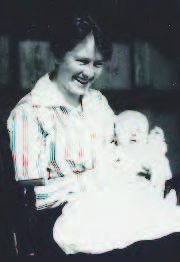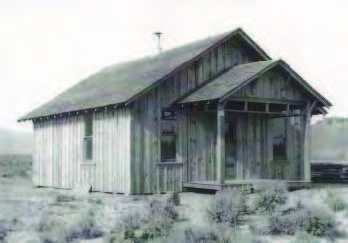Harold E. Smith’s Forest Service Christmas Story

“Harold E. Smith’s Forest Service Christmas Story” is by USDA Forest Service historian Rachel D. Kline.
As we approach the holiday season in the Forest Service during this unprecedented time, history shows us that our curtailed holiday activities during a difficult time are not really that unprecedented after all. In fact, there are reminders of how we can persevere and find greater meaning in the season. This story of a Forest Service Ranger and his wife during the Christmas of 1917 certainly resonates with our shared experience this year.

Angie and Lorene “Sandy” Smith on the front porch of the Pine Mountain Ranger Station.
U.S. Forest Service ranger Harold E. Smith and his wife Angie lived with their fourteen-month-old daughter Sandy at the remote Pine Mountain Ranger Station on the Deschutes National Forest. After working as a logger in southern Oregon for a time, Harold joined the Forest Service in 1911 and took Angie to live and work with him at the ranger station. In the shadow of Pine Mountain, they lived in a tent house until Harold and another ranger built a small-framed house for the station in 1914. It was in that tiny station that Sandy, whose given name was Lorene, was born in October 1916.
The Christmas of 1917 was unlike any other for the Smiths. As the country was immersed in the middle of World War I, pay was low and scarcity was the norm. The station was 36 miles southeast of the mill town of Bend, at an elevation 4,800 feet. Average temperature in winter was -25°. With the nearest trading center fifteen miles away and sixteen to eighteen inches of snow on the ground, Christmas presents and treats would be hard to come by. With such facts at hand, the Smiths opted to stay at the ranger station that Christmas. So, with that decision made, Angie asked Harold to get a tree for little Sandy. Harold recalled,
I concurred in her decision and started out in quest of an evergreen. I was rewarded by finding a perfect specimen of a lodgepole pine. It had grown in an open space, where it had access to sunlight from all sides, resulting in a perfectly formed crown.
When I brought in the tree and mounted it atop the filing cabinet, Angie took over. With a pair of scissors, some tin foil and an assortment of highly colored postal cards, she transformed the little evergreen into a sparkling mass of multicolored beauty. Sandy was too young to long-remember the tree, but the momentary effect was gratifying to behold. Her eyes danced with wonderment as she gazed at the tree glittering in the light of the wood fire, burning behind the isinglass door of the Coleman heater.

Pine Mountain Ranger Station, constructed in 1914.
That Christmas would be their last together; tragically, Angie died the next year during the 1918 influenza pandemic. Harold stayed with the Forest Service. He later took an assignment in Alaska, often bringing Sandy with him on his ranger boat while she did her schoolwork.
But that cherished Christmas in 1917 was to be held in Harold’s heart forever.
As we turned out the kerosene lamp that night, our happiness was complete. Furthermore, I believe we had learned something from that experience, a lesson that others might find useful and rewarding: that mere wealth is not necessarily a prerequisite to happiness. Happiness, on the other hand, can spring from mutual love, companionship and understanding.
The parallels in this Forest Service Christmas story to our own this year—even with what happened later to Angie—can offer comfort. Staying home to celebrate the holiday, some of us grieving the loss of beloved family and friends or simply the inability to gather with those we love, we too can find wonder in the glittering light of a decorated tree or by creating lasting holiday memories together. It is a simple thing. But it is these kinds of moments like the Smiths had on that Christmas a century ago that ground us in our shared history, our love for tradition, and our love for each other.
Rachel Kline is a historian for the USDA Forest Service. She holds a master’s degree in public history from Colorado State University and is a PhD candidate in history at the University of New Hampshire, where she is exploring women’s roles in the American conservation movement.
Quotes are from “Angie Smith, Oregon,” in Foresters Wives Clubs of Washington, D.C., Sampler of the Early Years (Washington D.C., 1980), 38-39. Photos are from OldSmokeys Newsletter, Fall 2011. You can read more of Harold Smith’s recollections here.

